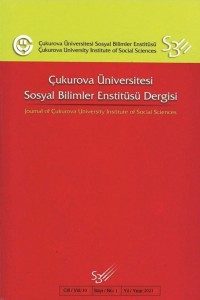Abstract
Küreselleşmenin kamu maliyesi alanına bir yansıması olan ikili gelir vergi sisteminin hem büyüme dostu hem de vergilemede basitliği ve etkinliği sağladığı savunulmaktadır. İskandinav ülkeleri tarafından ilk uygulamalarının görüldüğü bu sistemde her ne kadar teorik olarak tutarlı olsa da uygulamada bazı problemlere ve tartışmalara neden olmuştur. Özellikle vergilemede adalet ve gelir kaydırma konusundaki eleştiriler sistemin zayıf noktasını oluşturmaktadır. Çalışmada yukarıda bahsi geçen durumlar göz önünde bulundurularak sistemin avantaj ve dezavantajlarının neler olduğu detaylı bir şekilde incelenecektir. Bu bağlamda ikili gelir vergisi sisteminin tarihsel ve kurumsal sebepleri irdelenerek teorik yapı geniş kapsamda sunulacaktır. Ardından ikili gelir vergisi sistemini uygulayan ülkelerin birbirinden farklılaşan politikaları incelenecektir. Son olarak Türkiye’nin olarak ilgili sisteme yakınsamasının veya uygulamasının kazanımları ve kayıplarının neler olacağı ve sisteme yönelik getirilen eleştiriler noktasında nasıl bir politika izleyebileceği tartışılmaktadır.
References
- Bird, R. M., & Zolt, E. M. (2011). Dual income taxation: A promising path to tax reform for developing countries. World Development, 39(10), 1691-1703.
- Bø, E. E., Lambert, P. J., & Thoresen, T. O. (2012). Horizontal inequity under a dual income tax system: principles and measurement. International Tax and Public Finance, 19(5), 625-640.
- Boadway, R. (2005). Income tax reform for a globalized world: the case for a dual income tax. Journal of Asian Economics, 16(6), 910-927.
- Boadway, R. (2004). The dual income tax system-an overview. CESifo DICE Report, 2(3), 3-8.
- Coşkun Karadağ, N. (2014).Finansal Araçların Vergilendirilmesi, İhtiyari Beyan ve Sağladığı Vergi Avantajları. Cumhuriyet Üniversitesi İktisadi ve İdari Bilimler Dergisi, 15(2), 205-224.
- Durán Cabré, J. M. (2003). The dual tax as a flat tax with a surtax on labour income. Departamento de Economía Política y Hacienda Pública, Universidad de Barcelona, Barcelona.
- Çalcalı, Ö., & Yılmaz, A. (2013). Sermayenin Vergilendirilmesinde Adaletten Etkinliğe Doğru Yaşanan Kayma: Türkiye’de Ki Durum. Yönetim ve Ekonomi: Celal Bayar Üniversitesi İktisadi ve İdari Bilimler Fakültesi Dergisi, 20(2), 243-258.
- Celikkaya, A. (2010). Dual income tax: A reform option for personal income tax in Turkey. Business and Economic Horizons, (3), 47-57.
- Çelikkaya, A. OECD Ülkelerinde 1980 Sonrası Gelir Vergisi Reformlarının Değerlendirilmesi. Eskişehir Osmangazi Üniversitesi Sosyal Bilimler Dergisi, 11(1), 143-176.
- Çelikkaya, A. (2010). İkili Gelir Vergilemesi Modeli ve İskandinav Ülkelerindeki Uygulaması. ESOGÜ, İİBF Dergisi, 5(2), 101-128.
- Demirli, Y. (2009). Gelişmekte Olan Ülkelerde Vergi Reformları ve Türkiye’de Gelir Üzerinden Alınan Vergiler Açısından Değerlendirme, Hacettepe Üniversitesi Sosyal Bilimler Enstitüsü Maliye Ana Bilim Dalı, Yayımlanmamış Doktora Tezi.
- Demirli, Y., & Güran, M. C. (2009). Gelir Vergisi Sisteminin Alternatifleri ve Değerlendirilmesi. Hacettepe Üniversitesi İktisadim ve İdari Bilimler Fakültesi Dergisi, 27(2), 161-192.
- Doğan, A. (2016). İkili gelir vergisi, Türkiye’deki durumu ve uygulanabilirliği, Ankara Üniversitesi Sosyal Bilimler Enstitüsü Maliye Ana Bilim Dalı, Yayımlanmamış Yüksek Lisans Tezi.
- Eggert, W., & Genser, B. (2005). Dual income taxation in EU member countries. CESifo DICE Report, 3(1), 41-47.
- Genser, B. (2006). The dual income tax: Implementation and experience in Europen countries. Ekonomski Pregled, 57 (3-4), 271-288.
- Genser, B. & Schindler, D. (2007). Dual income taxation as a stepping stone towards a Europen corparate income tax. Cofe Discussion Papers, 7(5), 1-10.
- Genser, B., & Reutter, A. (2007). Moving towards dual income taxation in Europe. FinanzArchiv: Public Finance Analysis, 63(3), 436-456.
- Karakurt, B., & Akdemir, T. (2010). İkili Gelir Vergisi Sisteminin Adalet ve Etkinlik İlkeleri Açısından Değerlendirilmesi (Adalet Tartışmalarının Gölgesinde İkili Gelir Vergisi). Süleyman Demirel Üniversitesi İktisadi ve İdari Bilimler Fakültesi Dergisi, 15(1), 129-154.
- Keuschnigg, C., & Dietz, M. D. (2007). A growth oriented dual income tax. International Tax and Public Finance, 14(2), 191-221.
- Morinobu, S. (2004). Capital income taxation and the dual income tax. Policy Research Institute Discussion Paper Series, (04A-17), 7.
- Nielsen, S. B., & Sørensen, P. B. (1997). On the optimality of the Nordic system of dual income taxation. Journal of Public economics, 63(3), 311-329.
- Öz, N. S. (2006). Gelir vergisinde vergiyi doğuran olay: elde etme. Maliye ve Hukuk Yayınları.
- Pirttilä, J., & Selin, H. (2011). Income shifting within a dual income tax system: Evidence from the Finnish tax reform of 1993. Scandinavian Journal of Economics, 113(1), 120-144.
- Sørensen, P. B. (1994). From the global income tax to the dual income tax: Recent tax reforms in the Nordic countries. International Tax and Public Finance, 1(1), 57-79.
- Sørensen, P. B. (2001). ‘The Nordic Dual Income Tax—In or Out. Speech to Working Party, 2.
- Sorensen, P. B. (2007). The Nordic dual income tax: Principles, practices, and relevance for Canada. Canadian Tax Journal, 55(3), 557-602.
- Sorensen, P.B. (2009). Dual income taxes: A Nordic tax system. Paper prepared for the conference on New Zealand Tax Reform – Where to Next? at the Victoria University of Wellington, 2-34.
- Spengel, C., & Wiegard, W. (2004). Dual income tax: a pragmatic tax reform alternative for Germany. CESifo DICE Report, 2(3), 15-22.
- Radulescu, D. M. (2007). CGE Models and Capital Income Tax Reforms: The Case of a Dual Income Tax for Germany (Vol. 601). Springer Science & Business Media.
- Ranđelović, S. (2008). Dual income tax-an option for the reform of personal income tax in Serbia?. Ekonomski Anali/Economic Annals, 53.
- Vural, İ.Y. (2009). İkili gelir vergisi: Temel ilkeler ve uygulamalar, Prof. Dr. Mualla Öncel’e Armağan Cilt I, Ankara: Ankara Üniversitesi Hukuk Fakültesi Yayınları No:243,179-210.
- Zew Economic Studies, (2008). Dual income tax: a proposal for reforming corporate and personal income tax in Germany (Vol. 39). Physica-Verlag.
Details
| Primary Language | Turkish |
|---|---|
| Journal Section | Articles |
| Authors | |
| Publication Date | April 30, 2021 |
| Submission Date | October 30, 2020 |
| Published in Issue | Year 2021 Volume: 30 Issue: 1 |

